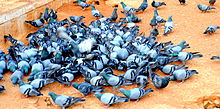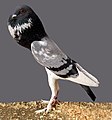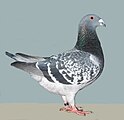Domestic pigeon
This article contains unreferenced categories. |
| Domestic pigeon | |
|---|---|

| |
| A selection of domestic pigeon breeds and colors; a result of centuries of selective breeding. The names of the depicted breeds can be seen here. | |
Domesticated
| |
| Scientific classification | |
| Domain: | Eukaryota |
| Kingdom: | Animalia |
| Phylum: | Chordata |
| Class: | Aves |
| Order: | Columbiformes |
| Family: | Columbidae |
| Genus: | Columba |
| Species: | |
| Subspecies: | C. l. domestica
|
| Trinomial name | |
| Columba livia domestica | |
| Synonyms | |
| |
The domestic pigeon (Columba livia domestica or Columba livia forma domestica)
Pigeons have held historical importance to humans as
History of domestication

Despite the long history of pigeons, little is known about the specifics of their initial domestication. Which

The earliest recorded mention of pigeons comes from Mesopotamia some 5,000 years ago.
The domestic pigeon was brought to
Because domestic and feral pigeons have extensively interbred with wild rock doves, genetically pure wild-type pigeons may not exist anymore, or are nearly extinct. This frequent admixture further muddies the true origins of pigeons.[6][7]
Genetics

From a genetic perspective, there are two loose ancestral
Markings
A
Another important aspect of pigeon markings is the pattern on the wing coverts, which exists in four variants; wild-type bar, check, T-check, and barless. T-check is the most dominant pattern, followed by check, barred, and the least dominant barless pattern.[15] Additionally, the modifiers spread and dilute affects the expression of the color; the spread gene spreads the color of the bird's tail to its entire body, while dilute lightens the bird's overall color, as if were a dye being diluted to reduce its saturation.[16][17]
Crest

A
Foot feathering
Pigeons with feathers growing on their hind feet have differently expressed genes: a hindlimb-development gene called Pitx1 is less active than normal, and a forelimb-development gene called Tbx5 that normally develops the wings is also active in the feet, causing both feather growth and larger leg bones. The cause of these changes is a change in the regulatory sequences of DNA that control the expression of the Pitx1 and the Tbx5 genes, rather than mutations in the genes themselves.[22][23] Pigeon foot feathering has been speculated to use similar pathways as extinct microraptorian dinosaurs, although in pigeons the foot feathering does not form an airfoil.[citation needed]
Hybridization
There is strong evidence that some divergences in appearance between the wild-type rock dove and domestic pigeons, such as checkered wing patterns and red/brown coloration, may be due to introgression by cross-breeding with the speckled pigeon.[24][25][26][27]
Domestic pigeons may be crossed with the ringneck dove (Streptopelia risoria) to create offspring, but the offspring are not fertile.[28][29]
Life history
Reproduction

Domestic pigeons reproduce exactly as wild
Baby pigeons are squabs, squeakers, or peeps, the latter two being
Domestic pigeons were selected to breed faster than their wild ancestors; a lack of a
Pigeon breeders sometimes suffer from an ailment known as bird fancier's lung or pigeon lung. A form of hypersensitivity pneumonitis, pigeon lung is caused by the inhalation of the avian proteins found in feathers and dung. It can sometimes be combated by wearing a filtered mask.[32]
Other pigeon related pathogens causing lung disease are
Uses
For food
Pigeons bred for meat are generally referred to as a meat or utility breed. The term "squab" can either refer to young birds or the meat harvested from them; these birds grow to a very large size in the nest before they fledge and are able to fly; during this stage of development they are often fattier and seen as being tastier than the fully-flighted adults. Squabs during this stage are valued as food; in neolithic and early agricultural communities they were an easy and reliable source of protein, the birds requiring only reliable sources of grains and water (which they independently foraged for) to enter breeding condition, and the rock formations they nested in would have made for attractive dwellings for early humans[citation needed].
Pigeon meat, both from squabs and from adult birds, are still a source of protein for people worldwide. Breeds of pigeons harvested for their meat during adulthood are collectively known as utility pigeons. For commercial meat production a breed of large white pigeon, the King pigeon, has been developed by selective breeding.
Homing pigeons

Homing pigeons are a specialized type of pigeon bred for navigation and speed. Originally developed through selective breeding to carry messages, members of this variety of pigeon are still being used in the sport of pigeon racing and the ceremony of releasing white doves at social events.
These breeds of domestic pigeons, especially when
Other potential cues used include
- The use of a sun compass[37]
- Nocturnal navigation by stars[38]
- Visual landmark map[39][40]
- Navigation by infrasound map[41]
- Polarised light compass[42]
- Olfactory stimuli[43] (see also olfactory navigation)
Display
Flying/sporting

Pigeons are also kept by enthusiasts for the enjoyment of Flying/Sporting competitions. Unlike racers, these birds are not released far from their home lofts; breeds such as tipplers are bred for the ability to hover above the loft for hours at a time. Their ability to hover for a long time shows the ability of the keeper to select for endurance.
Wild Pigeons naturally somersault when evading aerial predators such as large-bodied falcons; they are naturally selected by the extreme speeds that some stooping falcons reach (over 320 km/h (200 mph)), being able to dodge this attack at the last second. Tumbler and roller pigeons are bred to enhance this ability; some birds have been recorded to be able to somersault on the ground and land on its feet, and some breeds are even deliberately bred to a point where the rolling ability is debilitative, being wholly unable to fly due to it.
Exhibition breeds
Pigeon fanciers developed many exotic forms of pigeon through selective breeding. Perhaps the simplest form of display pigeon are those of white plumage, either truly albino or merely white-feathered; these white birds were seen as holy animals or heralds of peace and are well represented in both ancient and contemporary culture.
As pigeonkeepers accrued more experience, they started selecting for increasingly more unusual features in their birds; features such as unusual plumage patterns and colors, various crests, foot feathering, altered stance and proportion, or unusual behaviors are well represented in extant pigeon breeds. These birds are generally classed as fancy pigeons.
Pigeon shows are conventions where pigeon fanciers and breeders meet to compete and trade their fancy pigeons. The various pigeon breeds dubbed "American show" were developed specifically by pigeon show frequenters pursuing a certain show standard determined by the National Pigeon Association. Fanciers compete against each other at exhibitions or shows and the different forms or breeds are judged to a standard to decide who has the best bird.
There are many fancy or ornamental breeds of pigeons: among them are the
- Variety of fancy pigeons
-
Archangel showing its extensive iridescence
-
Valencian Figurita, one of the smallest breeds of pigeon
-
Portuguese tumbler, another small breed of pigeon
-
The Giant Runt, one of the largest pigeon breeds
Experimentation
Domestic pigeons are model organisms commonly used in laboratory experiments relating to biology; often to test medicines and chemical substances, or in cognitive sciences.
Pigeons have been trained to distinguish between cubist and impressionist paintings.[44] In Project Sea Hunt, a US coast guard search and rescue project in the 1970s/1980s, pigeons were shown to be more effective than humans in spotting shipwreck victims at sea.[45] Research in pigeons is widespread, encompassing shape and texture perception, exemplar and prototype memory, category-based and associative concepts, and many more unlisted here (see pigeon intelligence).
Pigeons are able to acquire orthographic processing skills,[46] which form part of the ability to read, and basic numerical skills equivalent to those shown in primates.[47]
Relation to humans
Domestic pigeons, especially the white birds which are referred to as "white doves", have had a long history in symbolism.
Charles Darwin was famously requested to write a book on pigeons during the process of writing his book, On the Origin of Species. He would subsequently take on pigeon fancying himself, which would ultimately lead to another book; The Variation of Animals and Plants Under Domestication.[31]
Illegal predator killing by enthusiasts
In the United States, some pigeon keepers illegally trap and kill hawks and falcons to protect their pigeons. It is legal in some places though. [48] In American pigeon-related organizations, some enthusiasts have openly shared their experiences of killing hawks and falcons, although this is frowned upon by some fanciers. Some of the major clubs condone this practice.[citation needed] It is estimated that almost 1,000 birds of prey have been killed in Oregon and Washington, and that 1,000–2,000 are killed in southern California annually. In June 2007, three Oregon men were indicted with misdemeanour violations of the Migratory Bird Treaty Act for killing birds of prey. Seven Californians and a Texan were also charged in the case.[citation needed]
In the West Midlands region of the United Kingdom pigeon fanciers have been blamed for a trap campaign to kill peregrine falcons. Eight illegal spring-loaded traps were found close to peregrine nests and at least one of the birds died. The steel traps are thought to have been set as part of a "concerted campaign" to kill as many of the birds as possible in the West Midlands.[49] [dead link]
Feral pigeons
Many domestic birds have escaped or been released over the years, and have given rise to the feral pigeon. As a result of natural variation, feral pigeons demonstrate a wide variety of plumages, ranging from closely resembling wild rock doves, to patterns directly inherited from their domestic ancestors, though over time a population tends to homogenize and adopt a plumage that suits their environment, such as camouflaging against black asphalt. The scarcity of the pure wild species is partly due to interbreeding with feral birds. Domestic pigeons can often be distinguished from feral pigeons because they usually have a metal or plastic band around one (sometimes both) legs which shows, by a number on it, that they are registered to an owner.[50]
Feral pigeons bear striking genetic resemblance to homing pigeons, supporting the idea that most feral pigeons trace their origins to homing pigeons who did not find their way home, or were otherwise sired by homing pigeons.[6] The huge numbers of birds released in pigeon races and loft owners breaking down their lofts and leaving the pigeons to fend for themselves may be a significant factor in the persistence of urban pigeons.
References
- ^ "Columba livia Gmelin, 1789" (Web data). ITIS Report. Retrieved 26 February 2008.
- S2CID 31939394.
- ISBN 978-0-7022-3641-9.
- ISBN 978-0-85390-013-9.
- .
- ^ ISBN 978-1-4419-0426-3.
- ^ a b Hester, Jessica Leigh (29 November 2021). "The Case for Pigeon-Watching". atlasobscura.com. Atlas Obscura. Retrieved 30 November 2023.
- ^ "Secret World of Pigeons Timeline". cbc.ca. CBC. Retrieved 30 November 2023.
- ^ Parks, Shoshi (25 January 2023). "Did Ancient Egypt Have a Pigeon Problem?". atlasobscura.com. Atlas Obscura. Retrieved 30 November 2023.
- ^ Kabir, M. Ashraful (18 October 2023). "Social and Basic Sciences Review". Researchgate.net. Retrieved 18 October 2023.
- ^ "The Royal Pigeons". birdnote.org. BirdNote. 23 February 2022. Retrieved 30 November 2023.
- ^ "5 Animals the Mughal Emperor Akbar loved". theheritagelab.in. The Heritage Lab. 3 July 2020. Retrieved 30 November 2023.
- ^ "Color". learn.genetics.utah.edu. University of Utah. Retrieved 16 November 2023.
- ^ "Recessive Red". learn.genetics.utah.edu. University of Utah. Retrieved 16 November 2023.
- ^ "Pattern". learn.genetics.utah.edu. University of Utah. Retrieved 16 November 2023.
- ^ "Spread". learn.genetics.utah.edu. University of Utah. Retrieved 16 November 2023.
- ^ "Dilute". learn.genetics.utah.edu. University of Utah. Retrieved 16 November 2023.
- ^ "The Secret of the Pigeon's Crest". www.science.org. Retrieved 28 May 2023.
- ^ "Crest". learn.genetics.utah.edu. Retrieved 28 May 2023.
- PMID 26104009.
- ^ "Crest". learn.genetics.utah.edu. University of Utah. Retrieved 30 November 2023.
- ^ "Foot Feathering". learn.genetics.utah.edu. Retrieved 28 May 2023.
- ^ "Pigeon foot feather genes identified | UNews". unews.utah.edu. Retrieved 28 May 2023.
- ^ Ottenburghs, Jente (12 December 2014). "Columbiformes". Avian Hybrids.[self-published source?]
- PMID 30014848.
- S2CID 87693174.
- ^ "Known Dove/Pigeon Hybrids". www.exoticdove.com. Retrieved 28 May 2023.
- ^ "Convergent Evolution of Head Crests in Two Domesticated Columbids Is Associated with Different Missense Mutations in EphB2". academic.oup.com. Retrieved 28 May 2023.
- ^ Gorman, Kate. "Bird lady of Haslet helps to elevate occasions". Star Telegram (15 Jun 2008). Archived from the original on 2 April 2019. Retrieved 25 June 2008.
- ^ a b Bodio, Stephen J. (15 July 2009). "Darwin's Other Bird—The Domestic Pigeon". allaboutbirds.org. The Cornell Lab of Ornithology. Retrieved 16 November 2023.
- ^ Boyd, Gavin; Din Ismail; Philip Lynch; Charles McSharry. "Process of Pigeon Fancier's Allergic Alveolitis.Current research activity into Pigeon Lung in Scotland: Epidemiological Studies". British Pigeon Fanciers Medical Research. Archived from the original (Web article) on 8 July 2008. Retrieved 22 January 2008.
- ^ Von Middendorff, A. (1859). "Die Isepiptesen Rußlands". Mémoires de l'Académie Impériale des Sciences de St. Pétersbourg. Série VI. 8: 1–143.
- JSTOR 41071133.
- PMID 9317275.
- S2CID 53184279.
- PMID 10409483.
- .
- ^ Baker, R.R. (1984). Bird Navigation: The Solution of a Mystery? London: Hodder & Stoughton.
- PMID 11104714.
- ProQuest 229557494.
- S2CID 4330244.
- doi:10.1080/00269786.1986.10736514 (inactive 31 January 2024). INIST 8067206.)
{{cite journal}}: CS1 maint: DOI inactive as of January 2024 (link - PMID 16812755.
- ^ "Pigeon Search and Rescue Project (Project Sea Hunt)". United States Coast Guard. 28 May 2009. Retrieved 12 January 2010.
- PMID 27638211.
- S2CID 33936018.
- ^ Milstein, Michael (9 June 2007). "Fight pits pigeon, hawk lovers". The Oregonian. Archived from the original on 2 January 2008. Retrieved 11 June 2007.
- ^ Smith, Lewis (30 May 2008). "Pigeon fanciers blamed for trap campaign to kill peregrine falcons" (Online news). London: Times Online. Retrieved 20 June 2008.
- ^ Porter, Cynthya. "Goodview man finds racing pigeon". Winona Post. Archived from the original on 18 July 2011. Retrieved 15 July 2008.



























